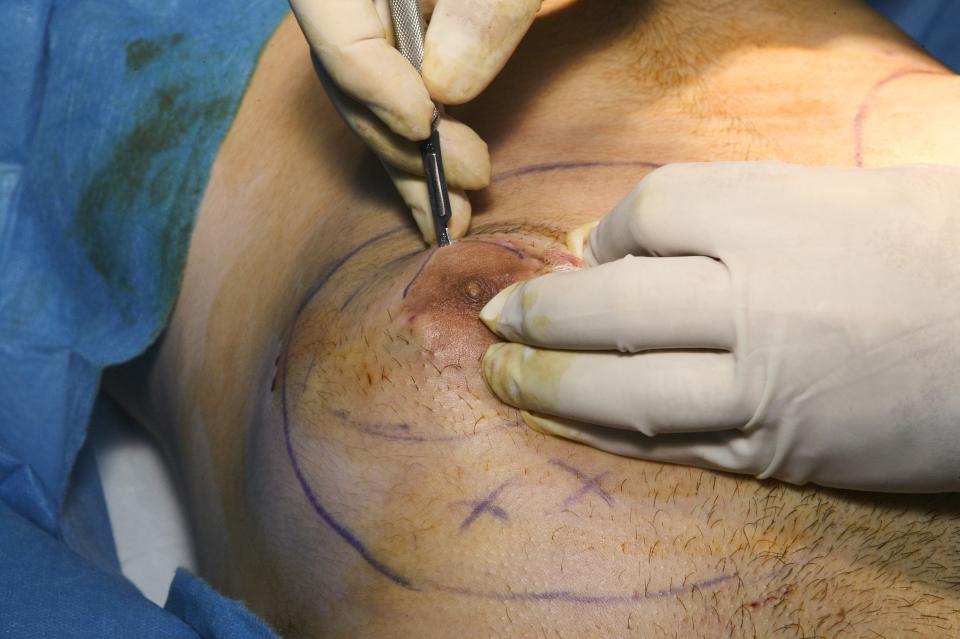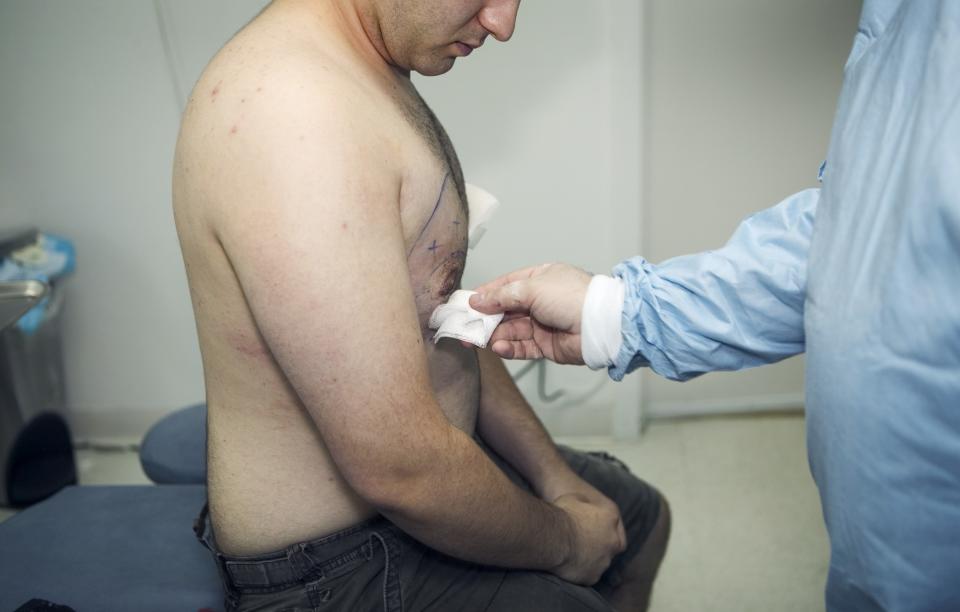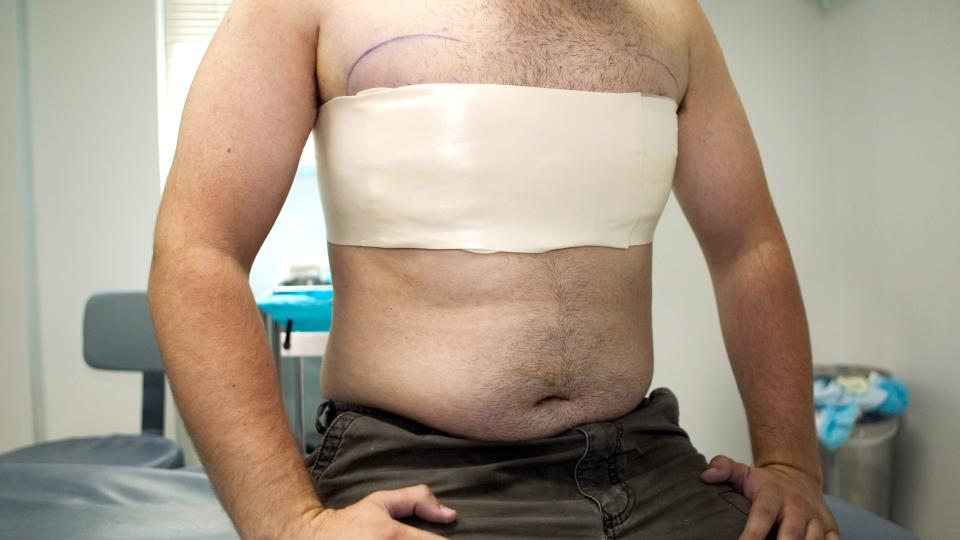Why More Men Are Getting Breast Reduction Surgery for Gynecomastia
You've probably heard the mocking term "man boobs" before. Used to describe male breasts that are larger than what traditional cisnormative beauty standards dictate, it might seem light-hearted, but for some men with gynecomastia, enlarged breasts are no joke. Gynecostamia is a health condition that leads to breast gland tissue enlargement in males, and men are increasingly turning to breast reduction surgery to combat it.
While breast reductions are most commonly associated with women, the procedure actually seems to be losing popularity among women and gaining momentum with men. The American Society of Plastic Surgeons (ASPS) reported a four percent decline in female breast reduction surgeries from 2015 to 2016 and a one percent increase in male breast reduction surgeries during the same time (as well as a 36 percent increase in male breast reductions from 2010 to 2016). Here's what to know about the procedure, including why more men are seeking it.
Can't men who want to reduce the size of their breasts just lose some weight?
"Like women, all men have fat and breast, or mammary, gland tissue in their chest," board-certified plastic surgeon Darren Smith explains to Allure. "Both of these components, however, are usually much less developed in men than in women. When these tissues are overdeveloped in men, a condition called gynecomastia, we can dramatically improve its appearance with a male breast reduction, or gynecomastia reduction procedure."
In other words, guys with gynecomastia aren’t hopping on surgeons’ tables to get rid of a little bit of fat they could conceivably work off in the gym. As the Washington Postreported, the root cause of gynecomastia is a hormonal imbalance between estrogen and testosterone. According to Mayo Clinic, there are several possible causes for this imbalance, including various medications (including some used to treat cancer and anxiety), health conditions (including hyperthyroidism and malnutrition), and use of alcohol and drugs (including marijuana, heroin, and amphetamines). When someone comes in seeking breast reduction surgery, Smith says the first step "is ruling out an underlying medical or medication-based problem, and fixing this if it is present."
Is gynecomastia more common among men in some age groups than others?
According to Mayo Clinic, gynecomastia affects men at different stages of their lives: More than 50 percent of male infants are born with enlarged breasts thanks to the effects of their moms’ estrogen, but the condition generally goes away within a few weeks of birth. Others experience swelling during puberty (thanks to those pesky hormone changes), but this usually goes away within six months to two years. About 25 percent of men experience gynecomastia when they're between ages 50 and 69, since testosterone may naturally begin to decline as men age. But men of all ages can experience the condition.

USA - Plastic Surgery - Matt Anderson - Gynecomastia
What's motivating the rise in male breast reduction surgery?
Gynecomastia itself doesn’t actually present many physical health risks, but it can definitely take a mental toll. One 2009 study noted that the condition “can cause patients considerable anxiety,” while another pointed to a “shame and stigma” that can come with it. Many patients with gynecomastia speak about being ridiculed because of their condition. “When you’re hot-dogging with friends and they’re doing titty-twisters, you laugh it off, but it hurts,” a breast reduction patient named David, 32, told the Post. "People want to be happy with what they see in the mirror every day, and I wasn’t happy with what I saw."
He’s far from the only one who has felt that way. “I don’t know that I had people making fun of me, but I knew people would look at it and see it,” another patient, Martin, 61, told the Post, explaining that he knows women he’s dated have “noticed” his enlarged breasts. A third man, "Carl," 33, told Refinery29 that enlarged breasts meant he endured jokes throughout his adolescence. Men like David, Martin, and Carl turned to surgery to gain self-esteem. “They want to migrate toward what’s considered the ideal male figure, which does not include overdeveloped breasts,” Marwan Khalifeh, a Washington-area surgeon, told the Post.
As for the recent increase in patients, it’s not because the surgery is a new thing. Smith points out that men are seeking more aesthetic procedures in general: As he points out, it's becoming more commonplace and less taboo for them to talk about plastic surgery. As liposuction technology has developed, breast reduction that relies on it has also become less invasive, upping its appeal.

USA - Plastic Surgery - Matt Anderson - Gynecomastia
So what does male breast reduction surgery involve?
As Smith explains, there are two basic kinds. The first is liposuction-based, and it's a good choice for patients who don't have "a lot of extra loose skin." In this procedure, two small incisions of three to four millimeters each are made under the breasts. "Numbing medicine is then infused into the breast," Smith says. "I like to first use an ultrasound handpiece to loosen the tissue." Next, the surgeon suctions excess tissue out of the incisions with a long, thin tube called a cannula, then uses a single stitch to close each incision.
Men return to work or school within a few days — "if the procedure is performed on a Friday," Smith says, "the patient is back at work on Monday" — and no general anesthesia or hospital stay is required. For the first few weeks after surgery, patients are often instructed to avoid intense exercise and wear a compression garment for support as their tissues heal.
The second kind of male breast reduction is performed much less frequently. It involves tissue excision, and it's for patients who have "a more extensive problem that includes loose skin," Smith explains: Merely removing some of the breast tissue's fatty part isn't enough, and some of the breast's glandular tissue has to be removed for optimal results. "These procedures are more closely related to breast reductions in women, as they are designed to eliminate more extra tissue and more extra skin. General anesthesia is required, and there are scars under the breast and around the nipple," Smith says. This procedure is also outpatient, but patients may need closer to a week to return to work or school.
Are there risks or side effects?
Smith says that while breast reduction surgery is very safe, pretty much any aesthetic surgery procedure comes with the risk of infection or bleeding, although these are rare. "Any kind of breast surgery, in men or women, carries a risk of nipple damage or loss of nipple sensation," he adds. "These are also extremely rare occurrences."
How much does the procedure cost?
Smith notes that cost depends on your location, your surgeon's level of experience, and the extent of your surgery, but says that $5000 to $10,000 is the usual range.
While the rise in male breast reduction surgery may seem surprising at first, the reality is that both men and women may feel a desire to change the size of their breasts. And while aesthetic surgery of all kinds has long been associated mainly with women, there's no reason men shouldn't pursue procedures that help them feel more confident in their bodies.
More on surgery and breast care:
Watch this cancer survivor dispel the myth that breasts equal femininity:
Follow Emma on Instagram and Twitter.


